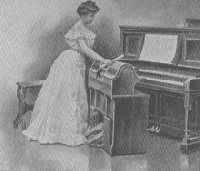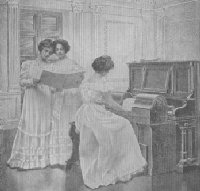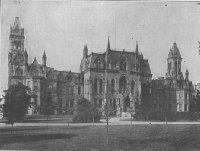In fact, he must suppress his loftiest inspirations by a most mechanical system of scales and finger exercises, before he can become even a fair player on such an instrument as the piano. However, necessity is the mother of invention, and the modern semi-automatic players have now come to the rescue, by affording us all a ready means of playing the most difficult music with our own individual coloring and expression—this too without the necessity of any tedious preliminary practice. Such instruments are well known and already have their accepted Place in the musical world.
The Simplex piano player is characterized by the simplicity of its construction. One of the accompanying cuts shows the instrument in playing position against the piano, its striker rods being in position over the keyboard, and its pedal lever connected to the loud or open pedal of the piano. The music rolls used are identically the same as those used on all self-playing organs and the like, because the Simplex is a pneumatically operated instrument. The music roll consists of a long sheet of paper provided with a series of perforations of such dimensions and locations as to co-operate with the mechanism of the player to produce the desired music. HOW THE PULSE IS MADE TO KEEP A RECORD OF ITS BEATS Among the modern inventions which have been utilized in connection with the healing art, an instrument called the spygmograph is considered of much value. A skilled physician is often able to detect in the pulse of his patient certain characteristics besides the mere rate, which are highly significant as regards the condition of the circulatory system. The range of these indications has been greatly extended by the spygmograph, an instrument invented by M. M. Chauveau and Marey, by which the pulse is made to write down a graphic representation of its action. The patient's arm having been placed on a suitable support, a little stud covered with soft leather is lightly pressed against the artery by a spring. The stud is in contact with the shorter end of a very light lever, the other extremity of which is furnished with a point, which registers its movements on a cylinder of blackened metal, made to rotate and advance longitudinally by clockwork; or, the record is taken on strips of flat smoked glass. As the motion is much magnified by the lever, every variation in the pressure of the blood in the artery during the beat of the pulse is distinctly and faithfully indicated. From the line so traced, the physician may obtain infallible data for judging of the condition of the heart, the action of its valves, etc. It is marvelous to observe the manner in which the curves of this instrument change their form when certain drugs are administered. The change in some cases occurs immediately, so that the eye can detect by inspection of the spygmographic curve, almost the instant at which the drug, was taken into the system, and the nature of its action on the heart. RESPIRATION REGISTERED IN CHARACTERS BY THE ACTION OF THE LUNGS
PHOTOGRAPHY AND THE USE OF THE CAMERA |


